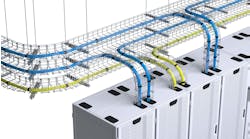Real-Time Data Solutions Will Transform the Data Center Industry in 2019
Jeff Klaus, GM of Intel Data Center Management Solutions, explores how real-time data solutions and new technology like edge computing are working to change and evolve the data center industry as we know it.
Jeff Klaus, GM of Intel Data Center Management Solutions
Today, we are living in a world where everything around us is connected, from our devices to our vehicles to the everyday technology that powers the way we live. In fact, digital transformation efforts like the Internet of Things (IoT) are already taking nearly every industry by storm with the introduction of new smart technologies and connected devices. Due to this increased connectivity and implementation of digital strategies, enterprises and organizations are receiving surges of actionable data that yesterday’s solutions simply cannot handle. This, in turn, will lead to a new era of data computation.
With a recent estimate finding the IoT market will grow to nearly $520 billion by 2021 and almost half of IT executives stating IoT is key in their digital business strategies, it’s clear the growth in IoT-connected technologies shows no signs of slowing down. This means enterprise IT leaders and decision makers need to adapt by leveraging new infrastructures and solutions to keep up with data demands. There’s been significant speculation that there’ll be an uptick in the use of next generation technologies like edge computing to provide real-time analysis on data center insights, and we can expect this speculation to transform into implementation as we move into 2019.
Enterprises Will Turn to Edge Computing Solutions
Industry projections show that enterprise-generated data from outside of traditional cloud computing centers could increase to upwards of 75 percent by 2022. Due to digital transformation initiatives like IoT, this shift in data will only continue as new solutions like edge computing emerge and take hold across the industry. With an increase in big data workloads and rise in real-time computing, traditional cloud computing architectures need to evolve to a more decentralized approach that processes data at or near the source.
Edge computing provides enterprises with the option to receive real-time data insights at or near the source versus relying on the cloud to complete analysis on stored data. Not only do edge solutions increase data computing efficiencies but will promote the further implementation of emerging technologies like data center management-as-a-service – better known as DMaaS. Through these technologies, enterprises will be able to scale operations, increase data security and reduce overall cost.
DMaaS Solutions Set to Enhance Edge Computing Growth
DMaaS takes traditional data center infrastructure management (DCIM) one step further by more cost effectively enabling metrics and analysis. As data processing moves toward the edge to account for the need of real-time data insights, enterprises will turn to an easy-to-use, low-cost cloud-based solution like DMaaS that provides the ability to monitor its data center infrastructure incrementally. This will be especially true for smaller environments as it provides a flexible alternative enabling companies to utilize edge computing.
In the next year, this emerging software platform will become more prevalent in enterprise data strategies as the use of edge computing becomes more commonplace. With nearly 60% of organizations citing the implementation of up to five SaaS solutions alongside an on-premise data center solution as identified in a recent Intel survey, the transition to a DMaaS solution is a logical next step and will be fueled by the growth in demand by edge computing insights.
Edge computing provides enterprises with the option to receive real-time data insights at or near the source versus relying on the cloud to complete analysis on stored data.
What’s this Mean for Traditional DCIM Solutions?
As the use of data center management solutions mature, organizations are challenged with allocating time, money and resources to upgrading their data center infrastructure with the goal of achieving operational efficiency. While existing DCIM solutions give IT teams insight into temperature, airflow, humidity, power consumption, security and other factors, DMaaS has emerged as the cloud-based, analytical powerhouse of data center monitoring with several providers like Schneider offering this new platform. By offering IT teams visibility enhanced by machine learning and cloud-based analytics coupled with the use of technologies like edge computing, DMaaS solutions will begin to phase out traditional DCIM solutions and take hold in enterprise data center strategies moving forward.
With the New Year right around the corner, enterprises IT leaders will look to evaluate and adopt next generation technologies while also diving into their current data center strategies and implement new solutions in order to stay one step ahead.
To learn more about the data center management as a service, download “The State of Data Center Management as a Service in 2018” white paper.
Jeff Klaus is GM of Intel Data Center Management Solutions.





